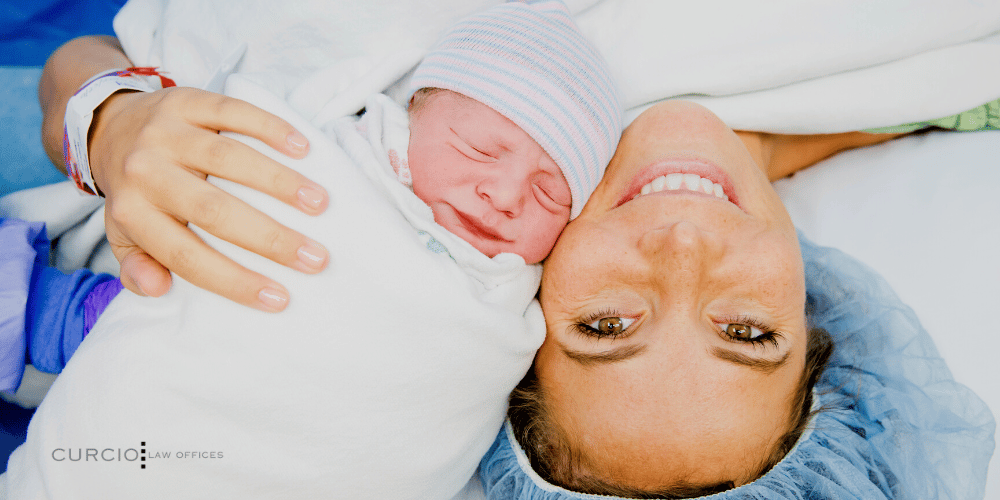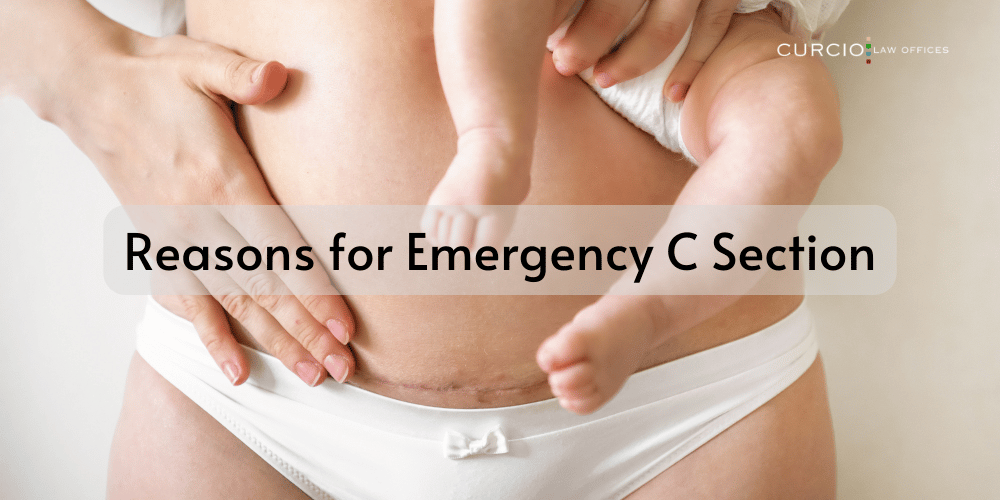What are the reasons for an emergency C-section? When do complications from an emergency or scheduled C-section rise to the level of medical negligence? When can a patient sue for damages?
Thanks to advances in technology, the amount of knowledge surrounding the birthing process has expanded. But, the list of potential complications has also grown.
C-sections are a common but still a major-surgical procedure that should only take place when a vaginal birth is too dangerous for the mother or child. As with any major procedure, complications and preventable mistakes can occur.
When an OB/GYN makes a careless error during either a scheduled C-section or an emergency C-section, you may have a valid medical malpractice claim. While mistakes can certainly happen during a scheduled C-section, they’re more likely to take place during an emergency C-section. So, what are the actual reasons for an emergency C-section? In what instances are surgeons supposed to forgo vaginal delivery and opt for an emergency cesarean?
First, let’s start with the basics.
What is a Cesarean Birth?
A Cesarean section, typically known as a “C-section,’ is a surgical procedure in which an unborn child is delivered via a surgical incision made through the mother’s stomach and uterine wall.
A cesarean delivery is a major surgery, and surgeons should only perform a C-section when medically necessary.
Potential Risks for Cesarean Birth
Like any major surgery, a caesarean birth comes with risks. A risk of bleeding, internal organ damage, and infection exists.
The risks for potential complications affect both the baby’s heath as well as the mother’s. Caesarean section complications can lead to lacerated bowels, blood clots, nerve damage, lung and heart complications, or even wrongful death.
What are the Different Types of C-Sections?
- A planned caesarean is when you and your doctor decide beforehand that the safest option for delivering your baby is via a caesarean section. This typically occurs when the mom has already had a previous C-section. Your physician will then schedule the caesarean section around your possible due date, potentially several months in advance.
- An unplanned C-section occurs when you were planning a vaginal birth, but before it was time for the vaginal delivery, your doctor decides that a caesarean section is safer for you and your baby. This decision can take place a few weeks, days, or even hours before the vaginal delivery was set to take place.
- An emergency C-section happens when delivery must happen urgently to keep either the mom or baby safe. This can happen regardless if you were planning to have a vaginal birth or a scheduled C-section.
While all of these sound similar, every C-section experience will differ. The actual procedure for an emergency C-section can differ greatly from those who have scheduled C-sections.

What Happens During an Emergency C-Section?
The main difference between regular C-sections and an emergency C-section is how well everyone is prepared. In an emergency C-section, everything must move very quickly. This includes administering pain medications and delivering the baby.
In scheduled C-sections, the mom is awake but doesn’t feel any pain. Local anesthesia is administered through a spinal injection, and this can take time.
However, in an emergency C-section, depending on the timing and hospital policies, the options for pain relief are different.
In some cases, the OBGYN and anesthesiologist may agree that there’s enough time to administer a spinal block. Or, the mom may have already had an epidural in place. But, depending on the circumstances, neither of those options may be possible. Some moms may have to undergo general anesthesia, meaning they won’t be awake to see their baby first.
Another difference between regular C-sections and an emergency C-section is the C-section incision used during the surgery. In non-emergency situations, a horizontal incision is cut right above the bikini line. However, during an emergency C-section, the surgeon may need to use a vertical incision on the uterus to deliver the baby faster. This may be necessary for preterm birth. Additionally, this may be necessary for those with adhesions from previous surgeries or fibroids that may block the uterine lining.
How the emergency C-section goes will depend on both the mom and baby’s health status, as well as the surgeon’s training.
If hospital policies caused you or your child preventable birth injuries, contact our Chicago hospital malpractice attorneys for a free consultation.
When Should an OBGYN Should Forgo Vaginal Birth and Perform an Emergency C-Section?
Prolonged Labor
Prolonged labor is when an attempt at a vaginal birth goes on much longer than normal. This may cause health problems for both moms-to-be as well as their babies.
After unsuccessful prolonged labor, the doctor may determine that it’s healthier for the mother and baby to have an emergency C-section.
The Baby’s Position
The baby’s head position may have already been a concern when the labor began. Sometimes, a physician may turn the baby from outside the womb using an external cephalic version, only to have the baby go back to the breech position. Regardless of the circumstances, labor won’t progress as normal if the baby can’t be coaxed into the head-down position.
If the baby is positioned with their bottom first (breech position), with their feet first, or is stretched sideways (transverse position), standard vaginal delivery may not be in the cards.
Exhaustion
Pregnant women, on average, experience a host of breathing problems since the baby takes up the space that would normally allow for lung expansion. So, sometimes, the mom may push as much as she possibly can, and even with a vacuum assist, she cannot complete the birth vaginally.
When the mom becomes exhausted, OBGYNs should start really looking for signs of possible complications, namely fetal distress. When the baby’s heart begins to beat too fast or too slow, then it’s time to switch to an emergency C-section procedure.
Health Condition
If the mother has health conditions that come up during labor, then an emergency C-section may be recommended by the treating physician. For example, the mother could have a herpes infection that appears in the vaginal area that becomes active, threatening to cause harm to the baby.
Also, if the mother’s blood pressure or heart rate skyrockets, then the doctor will advise her to stop pushing.
Tangled Umbilical Cord
If the cord gets tangled, compressed, or tries to come out before the baby, then the OB/GYN will likely recommend an emergency C-section.
A prolapsed umbilical cord occurs when the umbilical cord slips into the birth canal ahead of the baby. This carries a risk that it will be squeezed too much during a vaginal delivery and cut off the baby’s blood supply.
Placental Issues
Similar to the umbilical cord, the placenta can also complicate a vaginal delivery.
When part or all of the placenta tears away from the womb’s lining, this is called placental abruption. This placental abruption causes the baby to be stripped of the necessary nutrients and oxygen it needs to survive.
Also, moms with placenta previa may also need to undergo an emergency C-section. Placenta previa occurs when the placenta covers the vaginal opening to the birth canal.
Those who develop this condition earlier in the pregnancy usually don’t suffer from pregnancy complications since the placenta grows upward during the pregnancy.
Womb Tear
In certain rare cases, the increased pressure while trying to deliver the baby vaginally can tear or rupture the womb. Having a prior C-section increases the risk of uterine rupture.
What is C-Section Malpractice?
There are two separate categories for C-section malpractice: failure to perform a cesarean section and performing a cesarean section improperly.
A cesarean delivery is the protocol procedure in several instances. OBGYNs are trained to recognize these instances, as this is part of the medical standard of care.
Regardless of whether the baby has high blood pressure, an irregular heartbeat, or is tangled in the umbilical cord, a caesarean section or emergency caesarean provides a quick and relatively safe way to deliver a baby without risking brain damage or further injury.
Fetal Distress
If an OBGYN fails to notice the signs of fetal distress, fails to perform the emergency C-section, or fails to perform the emergency caesarean in a timely manner, the patient may have a medical malpractice claim, especially if the mom or baby is injured.
Prenatal Indicators
There are certain situations in which an OB/GYN should schedule a planned C-section way in advance. Medical conditions, results from blood tests, a preexisting pelvic fracture, or a prior C-section may all lead to this decision.
However, if the doctor fails to recognize these situations and proceeds onto a natural vaginal delivery, or if the doctor decides to perform an emergency C-section after the patients have sustained an accidental injury, then he or she has likely violated the standard of care.
Preeclampsia, eclampsia, placenta abruptio, and placenta previa are all conditions in which vaginal births are extremely dangerous. In all of these conditions, the mom’s body is either malfunctioning or the placenta is in a position that would make a vaginal birth dangerous or impossible. All of these conditions are extremely easy to identify, and the treating physician should almost always select a planned C-section as the best course of treatment for a healthy baby.
Furthermore, there are a number of other issues that should cause an OB/GYN to select a planned C-section, as avoiding emergency C-sections should also be a priority.
These issues can include twins, mothers who have had a previous C-section, a breech or transverse presentation, as well as a herpes diagnosis.
It is the physician’s duty to recognize these situations and plan for the birth accordingly. Any physician who fails to do so may be held liable in medical malpractice claims.
Starting an Emergency C-Section Too Late
Sometimes, it’s not good enough to perform an emergency cesarean birth eventually. When dangerous circumstances arise, and the doctor fails to act quickly, the consequences can be grave. OB/GYNs are trained not only to recognize that a cesarean section should be performed but also to recognize when.
If a doctor performs an emergency cesarean section after the mother or baby has sustained injuries, then he or she may also be held liable for damages.

Call a Chicago Birth Injury Lawyer at Curcio & Casciato Today
While an emergency C-section may have been medically necessary for your case, there are many instances in which the procedure isn’t. Whether your OBGYN missed the prenatal indicators or didn’t make a timely decision to alter the birth plan, the Chicago birth injury attorneys at Curcio & Casciato are here to help. We provide a free initial consultation and also provide services for birth injuries surrounding Chicago cerebral palsy claims, Chicago Erb’s palsy claims, and Chicago meconium aspiration syndrome claims. Call our office today to schedule your free consultation.



